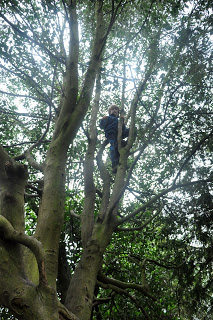 I have a source of pride to share with you; I was the best tree climber in my street as a child. I was small and skinny and could hold on to thin branches my brother and his friends were too big to handle.
I have a source of pride to share with you; I was the best tree climber in my street as a child. I was small and skinny and could hold on to thin branches my brother and his friends were too big to handle.
I loved climbing trees, we would climb really really high. Once a police car stopped and the policeman told us we were climbing too high, we came down, watched the car drive away and climbed straight back up. I can still recall intimately the feel and smell of each different tree I climbed regularly and the best routes up each tree.
So can you imagine how I felt reading this article from Openwaldorf? This is a website that describes itself as one Waldorf parent’s personal journey, with no official affiliation with Waldorf education. The article focuses on how terribly dangerous tree climbing is, the risks of tree climbing and includes a list of questions parents should ask their school:
- Were you aware that when a child falls 8 feet out of a tree, that it’s the same as hitting a brick wall at 30 MPH?
- Are children allowed to climb above unsafe falling surfaces?
- What are the rules for tree climbing at Waldorf?
- Were you aware that professional tree climbers do not recommend free climbing because it is too dangerous?
- How many children are allowed in the tree at one time?
- What kind of supervision is provided during tree climbs?
- Who is the the trained person in charge of tree climbing? Has anyone received training on proper tree climbing techniques?
- Has anyone signed off on specific trees as established climbing trees? Have the trees been certified for climbing by an arborist?
- What kind of instruction is provided for high tree climbing?
- Do you consider it safe for a child to ride a bike or a scooter without a helmet? Do you consider it safe for a child to climb 8 feet into a tree without a helmet? Does the school allow the children to climb trees?
- Do you provide the children with protective gear such as helmets, ropes, and gloves?
- Are children at Waldorf allowed to climb trees 8 feet or higher without protective gear? Is there a maximum height children are allowed to climb?
- Which is more dangerous to my child: (1) climbing more than 8 feet into a tree over an unsafe falling surface without protective gear, or (2) watching television?
“Source: OpenWaldorf.com, the most open site on the Internet for new and prospective Waldorf parents.”
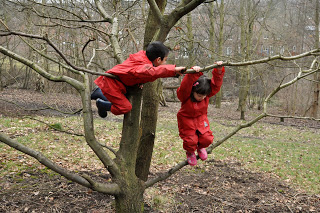
I must admit I felt a little sad after reading this. Then really panicked! I have had lots of experience of working with children and my career has included supporting children of all ages to take part in tree climbing. Had I been doing something really ridiculous and uncalled for?
Then I thought… If I could be made to feel this bad by one person over emphasising the risks that are inherent in an activity, then I felt for the myriad of parents and inexperienced practitioners who may read the list of questions posed in the article and decide that never,ever, ever would a child be allowed to climb in a tree. Accidents do happen, but children falling out of trees is uncommon. I know of two that I (or my students or team members from the last 10 years) have had to deal with. Only two accidents that have led to injury requiring hospitalisation (both broken arms). Risk management isn’t just about what is possible, but also about what is probable. Only longevity of experience can tell you this.
So when I had managed to breathe and actually think about what I do, I felt someone should look at the statistics that are quoted on the site and help people reading this get some perspective!
Luckily the wonderful Tinkering School founded by Gever Tulley has done just that in their follow up articles to the book, 50 dangerous things (you should let your children do): Some Thoughts on #28 – Climb a Tree
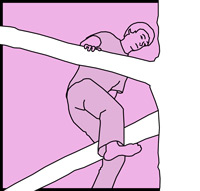
The article links to the same article that alarmed me and refutes some of the statistics used and points out some the things I felt instinctively:
And I leave you with this wonderful quote from a spokesman for the Royal Society for the Prevention of Accidents in the UK:
Climbing trees and falling out of them is all part of growing up and having small injuries helps children learn about risks. We take the view that it’s a good thing to try to equip children and young people and help them make informed decisions about the risks that they take.
My current insurance policy requires that the children I work with don’t climb higher than 1.5 meters, (*edit Jan 2012, this has now been amended to be 3x the height of the child. This makes sense considering a 3 year old and a 14 year old have very different levels of need and challenge when tree climbing) so I have to limit the children. They know they can only climb as high as my shoulder. If I tried to stop them completely, they would still do it, only more furtively and secretly and less safely. Interestingly this height restriction doesn’t limit them in every way, they have come up with lots of ways to challenge themselves. Last week the older children challenged themselves to see for how many seconds they could hang upside down from a branch and we often build rope bridges and slack lines so that the children can challenges themselves to go in a horizontal direction rather than a vertical.
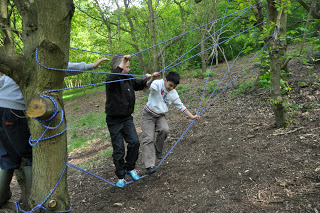
These boys constructed their own challenges with a spiders
web to cross, all only a small distance off the ground.
It later morphed into a zip wire slide.
If I could find an insurance company that would support me to allow kids to climb higher, then I would jump at the chance. The underwriters have said that they would only allow this if I had a qualification that trained me to run free tree climbing sessions (without ropes), So this is a plea: Does anyone know of a course or see themselves as a collaborator in establishing a free tree climbing qualification?
If that is you then do get in touch with me a mail(at)kindlingplayandtraining.co.uk
OK I can’t leave that list of questions alone alone, let’s try and answer some of them. Here is what I have found out…
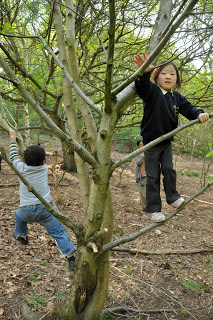
- A fall of 8 feet would be a velocoity of 22.6ft per second, that is the equivalent of 15.4090909 MPH
- A quote from a child (age nine) that I heard recently. “It’s better falling out of the trees in the woods because it is softer than falling over on the playground.”
- Useful rules we have for climbing trees: Children not to be put under pressure when climbing, allow children to focus on the activity and speak to them calmly and reassuringly. Adult to climb all trees that children climb to assess hidden risks. Children must only climb the trees they can climb unaided. Do not give ‘bunk ups’ or allow children to use climbing aids. Children should be able to climb down as well as up.
- Professional tree climbing companies that offer roped climbing experiences for children and individuals all acknowledge that free tree climbing is a normal part of childhood experience. They have a business to run and very good safety records. They don’t incorporate the two types of climbing.
- The number of children allowed in the tree at anyone time depends on the tree and the children.
- Children climbing trees should be supervised, the proximity of the supervision depends on the child and the trees they are climbing.
- There are currently no appropriate tree based free climbing courses in the UK.
- You should assess all trees that are climbable for safety. there is a fantastic list here
- Following a three points of contact rule is really useful for any climbing. Always have 3 body parts in contact with the tree, (hands, feet, knees, belly, bottom)
- “Expert” opinions, you should or shouldn’t make the child wear a helmet when climbing a tree. The Bicycle Helmet Safety Institute say:
“Children should not wear helmets on playgrounds or when climbing trees. The helmet can snag and the strap can asphyxiate them. Several deaths have been recorded, and more close calls”
- Ropes are provided but these are not used for climbing but traversing between trees. Some children like to have gloves when holding ropes but these are not so useful in trees and you miss the wonderful sensory experience on offer.
- Maximum heights are instituted by some insurance companies.
- I personally gain far more from my experiences of climbing in trees, I climbed a beautiful pollarded oak last weekend and looked down on a sea of bluebells. Breathtaking!











Oh how sad that Waldorf article made me and a little mad too! We go to a local woodland classroom once a month with my class of 3&4 year olds & the thing they look forward to most….climbing trees. keep on climbing 🙂
Our weeping willow tree was the children favourite piece of climbing equipment in our kindergarten. How sad it would have been if we said NO to climbing it … We would have had to chop it down, it would have been the only way to stop them and that would have been tragic! Some of my own greatest childhood memories are of tree climbing in the bush beside the creek!
Donna 🙂 🙂
I love this post – your passion comes shining through – but it makes me sad as well. Our regulations say that we can’t climb trees unless there is a soft fall surface underneath them, however (don’t tell anyone) we let the kids climb the trees in the bush. We always have someone standing there, so risk is minimal but the gains are enormous.
At my son’s school – a progressive approach – they are allowed to climb trees, make tree houses, make nests – you name it. The heights he climbs to make my heart pound sometimes, but I wouldn’t have it any other way. In my experience, kids are pretty damn good at knowing their limits.
Thank you all for your feedback.
Jenny, Climbing trees in the bush has it’s own soft fall surface built in does it not? I don’t know about the areas you work in but British woodlands have a lovely habit of putting layers and layers of leaves down. Just like bark and other playground surfaces 🙂
Wow that list was full on. I myself was an avid treeclimber as a child and loved it. Just recently we found a tree that I have supported my 3.5 year old to practice on. She can’t climb very high at all so it is perfect to test out for her. Too much safety also has it’s problems of not learning about risks I think. Thanks for the article.
Unbelievably sad to think we need insurance policies to allow children to climb trees. Samuel, my 13yr old son and his best friend spent this past entire weekend climbing and building tree decks. One in a
Ponderosa Pine, another high up in a Horse Chestnut tree. No helmets, no soft landing. They were covered in scrapes and pine resin.
Their weekend was full of laughter and adventure. They were free and wild and had the cuts and bruises to prove it. As a child, I spent hours climbing my favourite Silver Birch in my back garden. It was somewhere I could be alone and dream, sometimes tearful but on most days, extremely happy. It was my space and I loved the thrill and challenge of climbing and I STILL do!!!
Kids need to climb and HUG trees. Trees are our life source and should be celebrated and enjoyed. Thank you for sharing this post.I would be happy to support any campaign to get kids back into climbing trees.
Whats really important to remember here is that broken bones can be mended and in time they heal. That can’t always be said for children who are deprived of playing outdoors who suffer from stress related illnesses-their illness can last a lifetime.
Lets go outside!!!!!!!!!!! Marghanita Hughes
Thanks for the wonderful replies Marghanita and Erika. They bring to my mind this quote
“Better A broken bone than a broken spirit” Lady Allen of Hurtwood 1897-1976 (She was one of the champions of the adventure playground movement)
Great post Lily. I’ve had a recent tree climbing magic moment. I’ve been working with a highly anxious year 3 pupil who initially wouldn’t leave my side when we were in the woods. Today, even though there was a dark, gloomy feel in the woods because of the weather, he happily ran about with his partner playing 1,2,3 where are you? and finished the session by climbing a tree and proudly posing for a photo. Despite being no more than 1m off the ground you would have thought he had climbed Everest. I don’t think he will ever forget climbing his first tree, and I don’t think I will either!